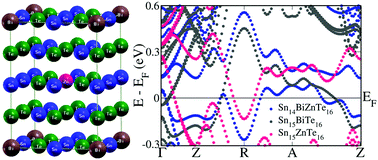当前位置:
X-MOL 学术
›
J. Mater. Chem. C
›
论文详情
Our official English website, www.x-mol.net, welcomes your feedback! (Note: you will need to create a separate account there.)
Bi and Zn co-doped SnTe thermoelectrics: interplay of resonance levels and heavy hole band dominance leading to enhanced performance and a record high room temperature ZT
Journal of Materials Chemistry C ( IF 6.4 ) Pub Date : 2019/12/20 , DOI: 10.1039/c9tc06490g U Sandhya Shenoy 1, 2, 3, 4, 5 , D Krishna Bhat 1, 5, 6, 7, 8
Journal of Materials Chemistry C ( IF 6.4 ) Pub Date : 2019/12/20 , DOI: 10.1039/c9tc06490g U Sandhya Shenoy 1, 2, 3, 4, 5 , D Krishna Bhat 1, 5, 6, 7, 8
Affiliation

|
Lead free SnTe with a tunable electronic structure has become the front runner in eco-friendly thermoelectrics. Herein, we show through first-principles density functional theory calculations that Bi and Zn doping introduces a resonance level in SnTe. The dominance of the heavy hole valence band at room temperature in Bi–Zn co-doped SnTe leads to a record high room temperature ZT of ∼0.3 (at 300 K) for SnTe based materials. The increase in the Seebeck coefficient value due to the interaction between the resonance states and formation of the nanoprecipitates leading to an appreciably low lattice thermal conductivity of 0.68 W m−1 K−1 results in a peak ZT of ∼1.6 at 840 K. A record high ZTaverage of ∼0.86 with 300 K and 840 K as cold and hot ends, respectively, makes Bi–Zn co-doped SnTe a potential material for thermoelectric applications. This strategy of using two resonant dopants, to not only improve the room temperature ZT but also high temperature values, can very well be extended to other systems.
中文翻译:

Bi和Zn共掺杂SnTe热电材料:共振能级和重空穴能级的相互作用导致增强的性能和创纪录的室温ZT
具有可调电子结构的无铅SnTe已成为环保型热电产品的领先者。在此,我们通过第一原理密度泛函理论计算表明,Bi和Zn掺杂会在SnTe中引入共振能级。Bi-Zn共掺杂SnTe在室温下的重空穴价带占主导地位,导致SnTe基材料的室温ZT达到创纪录的〜0.3(在300 K下)。由于共振态与纳米沉淀物形成之间的相互作用而导致的塞贝克系数值增加,导致0.68 W m -1 K -1的晶格热导率明显降低,导致840 K时的ZT峰值约为1.6。最高ZT平均值分别以300 K和840 K作为冷端和热端的〜0.86的阻值,使Bi-Zn共掺杂SnTe成为热电应用的潜在材料。使用两种谐振掺杂剂的这种策略不仅可以改善室温ZT,而且可以提高高温值,可以很好地扩展到其他系统。
更新日期:2020-02-13
中文翻译:

Bi和Zn共掺杂SnTe热电材料:共振能级和重空穴能级的相互作用导致增强的性能和创纪录的室温ZT
具有可调电子结构的无铅SnTe已成为环保型热电产品的领先者。在此,我们通过第一原理密度泛函理论计算表明,Bi和Zn掺杂会在SnTe中引入共振能级。Bi-Zn共掺杂SnTe在室温下的重空穴价带占主导地位,导致SnTe基材料的室温ZT达到创纪录的〜0.3(在300 K下)。由于共振态与纳米沉淀物形成之间的相互作用而导致的塞贝克系数值增加,导致0.68 W m -1 K -1的晶格热导率明显降低,导致840 K时的ZT峰值约为1.6。最高ZT平均值分别以300 K和840 K作为冷端和热端的〜0.86的阻值,使Bi-Zn共掺杂SnTe成为热电应用的潜在材料。使用两种谐振掺杂剂的这种策略不仅可以改善室温ZT,而且可以提高高温值,可以很好地扩展到其他系统。



























 京公网安备 11010802027423号
京公网安备 11010802027423号